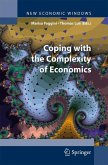This valuable book contributes substantively to the current state-of-the-art of macroeconomics. It provides a method for building models in which business cycles and economic growth emerge from the interactions of a large number of heterogeneous agents. Drawing from recent advances in agent-based computational modeling, the authors show how insights from dispersed fields can be fruitfully combined to improve our understanding of macroeconomic dynamics.
by exploiting the disequilibrium and non linear relationships among economic aggregates. Prom an empirical point of view, this approach resemblaces the old NBER view, according to which: "the business cycle [. . . ] consists of - pansions occurring at about the same time in many economic activities, f- lowed by similairly general recessions, contractions, and revivals which merge into the expansion phase of the next cyxle" (Burns and Mitchell, 1946). They add that the movement, although recurrent, is not periodic, lasting from 1 to 12 years, and it is not divisible into shorter cycles. Of course, both approaches are not free from limits and inconsistencies. In spite of the equilibrium approach having nowadays became the workhorse of modern macroeconomics, for example, their users still find enormous d- ficulties in explaining why small shocks produce large fluctuations. A well known argument in multi sector real business cycle models (see e. g. Long and Plosser, 1983) is that as the number of sectors or industries considered in the analysis becomes large, aggregate volatility must tend to zero very quickly. This result, which follows directly from the Law of Large Numbers (LLN), rests on the hypothesis that each sector is periodically buffeted with idiosyncratic, identically and independently distributed shocks to Total F- tor Productivity (TFP).
by exploiting the disequilibrium and non linear relationships among economic aggregates. Prom an empirical point of view, this approach resemblaces the old NBER view, according to which: "the business cycle [. . . ] consists of - pansions occurring at about the same time in many economic activities, f- lowed by similairly general recessions, contractions, and revivals which merge into the expansion phase of the next cyxle" (Burns and Mitchell, 1946). They add that the movement, although recurrent, is not periodic, lasting from 1 to 12 years, and it is not divisible into shorter cycles. Of course, both approaches are not free from limits and inconsistencies. In spite of the equilibrium approach having nowadays became the workhorse of modern macroeconomics, for example, their users still find enormous d- ficulties in explaining why small shocks produce large fluctuations. A well known argument in multi sector real business cycle models (see e. g. Long and Plosser, 1983) is that as the number of sectors or industries considered in the analysis becomes large, aggregate volatility must tend to zero very quickly. This result, which follows directly from the Law of Large Numbers (LLN), rests on the hypothesis that each sector is periodically buffeted with idiosyncratic, identically and independently distributed shocks to Total F- tor Productivity (TFP).








